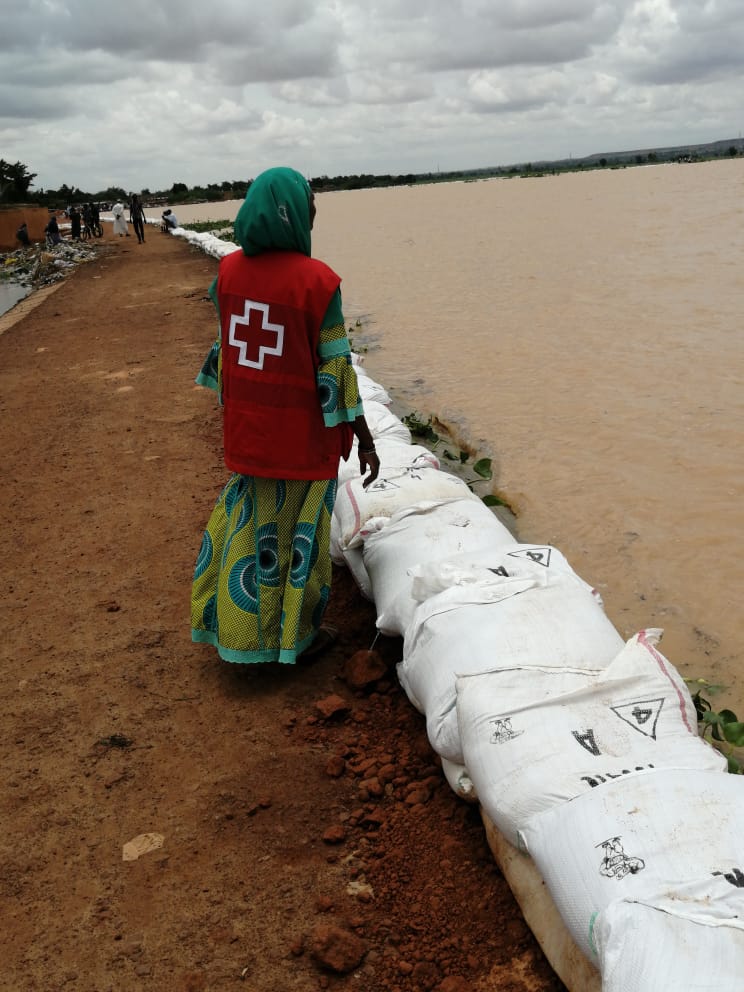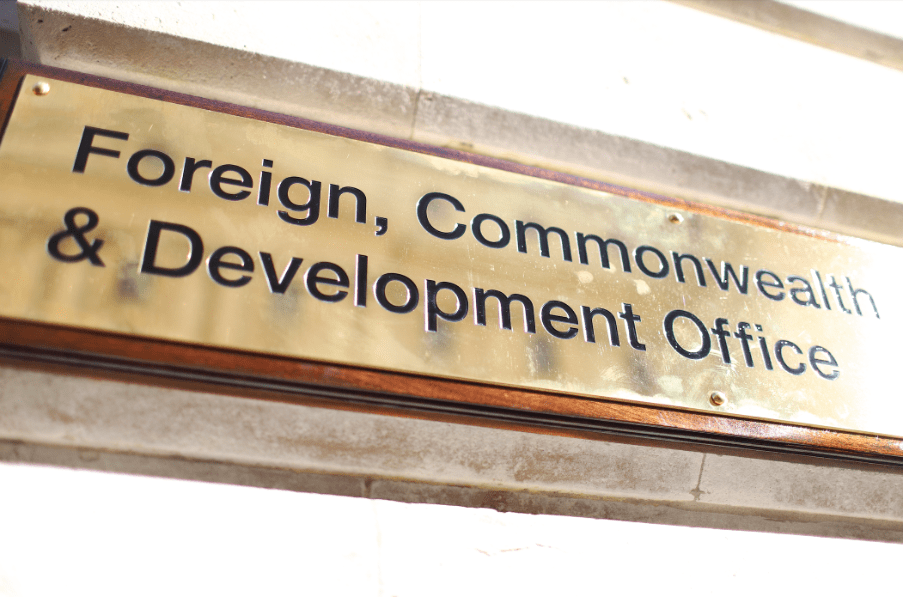The double affliction: conflict and natural hazard – the importance of tackling disaster risk amidst insecurity.
By Mark Weegmann, on 28 June 2021
This blog is also posted on The Anticipation Hub.
In January 2015, Storm Huda brought heavy snow, torrential downpours, and strong wind across the Levant. For Gaza and the West Bank in occupied Palestinian territories this resulted in the death of three children and one adult, almost 2,000 households newly evacuated or displaced, and extensive damage to fields, greenhouses, and livestock affecting 9,000 farmers (IFCR, 2015). It triggered a state of emergency and an international response effort. Whilst localised damage was reported in Israel, having similar exposure, the scale and impact were not comparable.

Storm water fills the streets of Shati’ Refugee Camp (Beach Camp) in Gaza, where 82,000 refugees are living. (© ICRC / il-e-01841, 2010)
Disasters and conflict
An unhappy confluence exists between states experiencing fragility, conflict, and violence suffering heightened disaster risks from natural hazards. Disaster deaths are 40% higher in these settings (Marktanner, et al., 2015) and they disproportionately rank ‘highly at risk’ to disasters and crises (EC, 2021). This is not surprising given our understanding of the social conditions that contribute to transforming hazard into disaster. Evidence demonstrates how conflict exasperates vulnerabilities, undermines resilience and coping capacities, increases exposure through displacement, and can even heighten hazard risk through environmental degradation (Harris, et al., 2013). The result of this compounding conflict and disaster risk is a concentration and exasperation of human suffering.
By the time Storm Huda reached Palestinian territories, there were still 100,000 people displaced and 18,000 homes destroyed or severely damaged from the outbreak of fighting in Gaza Strip the previous summer (ICRC, 2015). Damage to the energy, water, and sanitation infrastructure meant that much of the area had only partial running water and electricity for parts of the day. When a second winter cold wave hit in February, this had deadly consequences. The use of unsafe heating to stay warm, like open fires or electric heaters, caused a 16-month-old child in Northern Gaza, a 22-year-old mother and her 2-month-old baby in Nablus, and three children of the same family, aged 3, 4 and 15, to die from fires breaking out in residential homes and temporary shelters (UNICEF, 2015).
When an estimated 1.5 billion people today live in fragile and conflict-affected states (EC, n.d.), and 80% of total international humanitarian needs are focused in these areas (World Bank, 2021), disaster research and disaster risk reduction (DRR) efforts must account for this confluence if our efforts towards the sustainable development goals (notable SDG 11) are to be realised. DRR is, however, notably absent in these contexts ($1.30 spent on DRR for every $100 spent on response (Peters & Budimir, 2016)). There is a moral imperative to reduce suffering, operational advantage to decrease costly humanitarian interventions, and practical benefit lessening the humanitarian burden, to develop effective approaches and tools to change this.
Acting early: reducing disaster impacts
Anticipatory Action approaches – defined as “a set of actions taken to prevent or mitigate potential disaster impacts before a shock or before acute impacts are felt. The actions are carried out in anticipation of a hazard impact and based on a prediction of how the event will unfold” (IFRC, 2020. p. 351) – can provide one such tool. It can be useful because it is implemented through humanitarian actors who are already operational within these contexts, target vulnerabilities which are shown to have been exasperated by conflict, and the short lead times of the intervention enable a highly targeted response that alleviate specific needs that have a high probability of occurring (Wagner & Jaime, 2020). Yet, despite some initial pilots, Anticipatory Action is not fully functional in conflict situations yet. Evidence in non-conflict settings demonstrate Anticipatory Action’s ability to reduce operational costs, improve project design, and reduce negative disaster outcomes for affected communities (Weingärtner & Wilkinson, 2019).
Given the low baseline for DRR – including Anticipatory Action – in conflict-affected contexts, there is need to invest in understanding the unique and contextual interactions between disaster and conflict risks, how these inter-relate, and what the consequences are. A key component for implementing Anticipatory Action interventions is to understand not only what the weather will be, but what the weather will do to at-risk communities (Harrowsmith, et al., 2020). This is understanding how hazard, exposure, and vulnerability affect people living in conflict, and in what way the conflict compounds these disaster risks. With this, building blocks for appropriate interventions can be built.
For example, in the West Bank, houses close to the separation wall have experienced frequent flooding during heavy rain due to the wall impeding the proper flow and drainage of the rain. Drainage pipes running under the wall often get blocked but clearing them is often challenging due to access constraints. With advanced forecasts of rainfall, pre-positioning water pumps in these localities could prevent rainwater accumulating and flooding the surrounding homes.

Niger Red Cross implementing early action protocol to successfully reinforce part of the embankment holding back the flooded River Niger (CRN / Red Cross Red Crescent Climate Centre, 2020)
Scaling up Anticipatory Action to conflict-contexts
Understanding these risks exacerbated by conflict is therefore crucial for Anticipatory Action. This research aims to build on the evidence base around the impacts that the double vulnerability has on populations affected by armed conflict (Peters, et al., 2019) by conducting a comprehensive historical review of disaster impacts in conflict affected settings. This is focused on the Palestine and Darfur regions & the three protocol areas of Sudan as case studies. It builds on the ICRC and The Red Cross Red Crescent Climate Centre’s research agenda of Climate and Conflict 2020, and particularly key research questions about Anticipatory Action in situations of conflict (IFRC, 2020).
It seeks to establish a database of the impacts that disasters caused by hydro-meteorological hazards have had in Palestine and Sudan since 2010, understanding 1) who were affected, 2) how they were affected, and 3) in what way the conflict context relates to the disaster impact. This impact analysis is conducted through collating ‘grey literature’ (needs assessments, situational reports, operational updates of humanitarian organisations) supplemented by academic research.
Generating a picture of historical disaster impacts is critical for exploring which Anticipatory Action interventions can reduce the impacts of future disasters. The output will be used to present a scenario of the types of disaster profiles – and their impacts – that these case studies are likely to experience in the future. For this, a review of potential actions will demonstrate how and why certain activities might be relevant. Interviews with practitioners holding expert academic, sectoral, or contextual experience will provide field-based insights. Combined, the challenges of Anticipatory Action in conflict-affected contexts will be explored, along with their opportunities to provide a practical analysis aimed ultimately at improving DRR in states affected by conflict and instability.
This research will feed into wider work being done aimed at reducing disaster risks by using Anticipatory Action in conflict-affected areas. In Palestine, this could mean that the cold waves and heavy rainfall that struck six out of the past ten years, do not consistently result in mass displacement, shelter destruction, injury, and fatality. With three days advanced warning of extreme low-temperatures, the Palestinian Red Crescent Society could distribute winterisation items – like blankets and safe heaters – along with information & educations campaigns as to how to safely heat household to those living in tents and unprotected shelters. As a result, further loss of life could be prevented. Given the recent flare up in violence – damaging an additional 17,000 shelters (2,000 extensively) (OCHA, 2021) – reducing disaster risks remains an imperative.
This study is conducted as a Master’s Thesis for the MSc Risk and Disaster Science course at the Institute for Risk and Disaster Reduction, University College London (supervised by Prof Ilan Kelman). It is done in collaboration with the Red Cross Red Crescent Climate Centre (supervised by Catalina Jaime, Climate and Conflict Manager), as a contribution to their work on scaling up Anticipatory Action in conflict-affected contexts. For more information, you can contact Mark Weegmann, graduate student an UCL and Junior Research at the Red Cross Red Crescent Climate Centre.
This work is supported by the Danish Red Cross with funds from the Ministry of Foreign Affairs, Denmark.
 Close
Close




